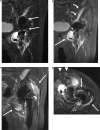Evaluating Hip Periprosthetic Joint Infection with Metal-artifact-reduction MR Imaging
- PMID: 38233192
- PMCID: PMC11733511
- DOI: 10.2463/mrms.mp.2023-0028
Evaluating Hip Periprosthetic Joint Infection with Metal-artifact-reduction MR Imaging
Abstract
Purpose: To evaluate the significant findings of hip periprosthetic joint infection (PJI) using metal-artifact-reduction (MAR) MRI and to compare the MRI results to other clinical markers.
Methods: The results of MRI, including two-dimensional fast-spin echo sequences with increased bandwidth and multi-acquisition variable-resonance image combination selective for hips with orthopedic implants at 1.5T (from April 2014 to November 2021), were retrospectively assessed for imaging findings and diagnostic impressions by two radiologists. Clinical data and courses were also investigated. Univariate and multivariate analyses were performed to identify the significant MRI findings in patients with hip PJI and those who underwent surgical intervention. The MRI impressions were compared with other clinical markers in diagnosing hip PJI.
Results: Thirty-seven hip joints in 24 Asian patients (age = 73.9 ± 10.8 years; 18 females) were included. Twelve hip joints (32%) had PJI; seven underwent a surgical intervention. The significant findings for hip PJI included periosteal edema of the acetabulum, intermuscular edema, intramuscular fluid collection, and lymphadenopathy (P < 0.05). In the cases with surgical intervention, the significant findings included capsular distension, capsular thickening, an osteolysis-like pattern of the femur, subcutaneous fluid collection, and lymphadenopathy (P < 0.05). The MRI impressions had high diagnostic significance for both hip PJI cases and those with surgical intervention (P < 0.001). The MRI impression was more significant for hip PJI than the other clinical markers (P < 0.05), while the other clinical markers were more significant in the cases with surgical intervention (P < 0.05).
Conclusion: The significant findings in the hip PJI cases included acetabular periosteal edema, intermuscular edema, intramuscular fluid collection, and lymphadenopathy. The significant findings in the cases with surgical intervention included capsular distention, capsular thickening, a femoral osteolysis-like pattern, subcutaneous fluid collection, and lymphadenopathy. The utilization of MAR MRI demonstrated great diagnostic significance for hip PJI.
Keywords: MRI; hip; metal-artifact-reduction; multi-acquisition variable-resonance image combination selective; periprosthetic joint infection.
Conflict of interest statement
The authors have no conflicts of interest to declare.
Figures




Similar articles
-
Diagnosis of Periprosthetic Hip Joint Infection Using MRI with Metal Artifact Reduction at 1.5 T.Radiology. 2020 Jul;296(1):98-108. doi: 10.1148/radiol.2020191901. Epub 2020 May 12. Radiology. 2020. PMID: 32396046
-
Diagnostic Value of Advanced Metal Artifact Reduction Magnetic Resonance Imaging for Periprosthetic Joint Infection.J Comput Assist Tomogr. 2022 May-Jun 01;46(3):455-463. doi: 10.1097/RCT.0000000000001297. Epub 2022 Apr 19. J Comput Assist Tomogr. 2022. PMID: 35467584
-
Diagnostic accuracy of MRI with metal artifact reduction for the detection of periprosthetic joint infection and aseptic loosening of total hip arthroplasty.Eur J Radiol. 2020 Oct;131:109253. doi: 10.1016/j.ejrad.2020.109253. Epub 2020 Aug 31. Eur J Radiol. 2020. PMID: 32937252
-
The role of advanced metal artifact reduction MRI in the diagnosis of periprosthetic joint infection.Skeletal Radiol. 2024 Oct;53(10):1969-1978. doi: 10.1007/s00256-023-04483-5. Epub 2023 Oct 24. Skeletal Radiol. 2024. PMID: 37875571 Free PMC article. Review.
-
Metal Artifact Reduction MRI in the Diagnosis of Periprosthetic Hip Joint Infection.Radiology. 2023 Mar;306(3):e220134. doi: 10.1148/radiol.220134. Epub 2022 Nov 1. Radiology. 2023. PMID: 36318029 Review.
References
-
- Kapadia BH, Berg RA, Daley JA, Fritz J, Bhave A, Mont MA. Periprosthetic joint infection. Lancet 2016; 387:386–394. - PubMed
-
- Beam E, Osmon D. Prosthetic joint infection update. Infect Dis Clin North Am 2018; 32:843–859. - PubMed
-
- Trebse R, Pisot V, Trampuz A. Treatment of infected retained implants. J Bone Joint Surg Br 2005; 87:249–256. - PubMed
-
- Grammatopoulos G, Kendrick B, McNally M, et al. Outcome following debridement, antibiotics, and implant retention in hip periprosthetic joint infection-an 18-year experience. J Arthroplasty 2017; 32:2248–2255. - PubMed
-
- Nurmohamed FRHA, van Dijk B, Veltman ES, et al. One-year infection control rates of a DAIR (debridement, antibiotics and implant retention) procedure after primary and prosthetic-joint-infection-related revision arthroplasty-a retrospective cohort study. J Bone Jt Infect 2021; 6:91–97. - PMC - PubMed
MeSH terms
Substances
LinkOut - more resources
Full Text Sources
Medical
Miscellaneous

